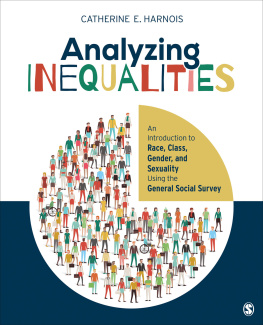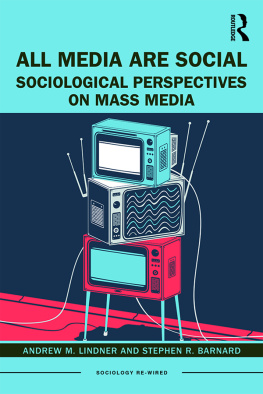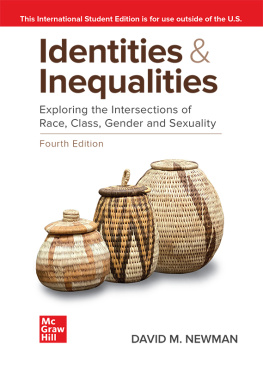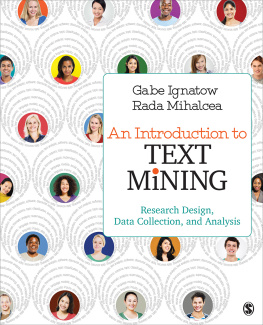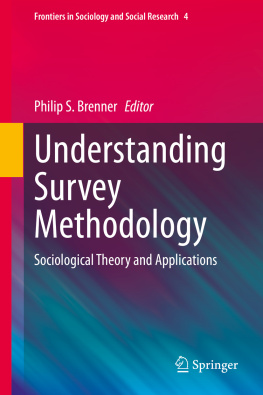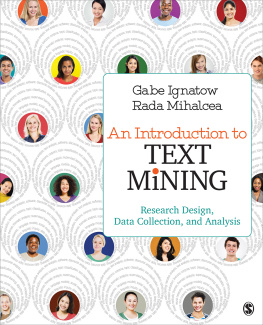Analyzing Inequalities
Sara Miller McCune foundedSAGE Publishing in 1965 to support the dissemination of usable knowledge andeducate a global community. SAGE publishes more than 1000 journals and over 800new books each year, spanning a wide range of subject areas. Our growingselection of library products includes archives, data, case studies and video.SAGE remains majority owned by our founder and after her lifetime will becomeowned by a charitable trust that secures the companys continuedindependence.
Los Angeles | London | New Delhi | Singapore | Washington DC | Melbourne
Analyzing Inequalities
An Introduction to Race, Class, Gender, and Sexuality Using theGeneral Social Survey
- CATHERINE E. HARNOIS
- Wake Forest University

- Los Angeles
- London
- New Delhi
- Singapore
- Washington DC
- Melbourne
Copyright 2018 by SAGE Publications, Inc.
All rights reserved. No part of this book may be reproducedor utilized in any form or by any means, electronic or mechanical, includingphotocopying, recording, or by any information storage and retrieval system,without permission in writing from the publisher.
FOR INFORMATION
SAGE Publications, Inc.
2455 Teller Road
Thousand Oaks, California 91320
E-mail: order@sagepub.com
SAGE Publications Ltd.
1 Olivers Yard
55 City Road
London, EC1Y 1SP
United Kingdom
SAGE Publications India Pvt. Ltd.
B 1/I 1 Mohan Cooperative Industrial Area
Mathura Road, New Delhi 110 044
India
SAGE Publications Asia-Pacific Pte. Ltd.
3 Church Street
#1004 Samsung Hub
Singapore 049483
Library of Congress Cataloging-in-Publication Data
Names: Harnois, Catherine E., author.
Title: Analyzing inequalities : an introduction to race, class, gender, andsexuality using the general social survey / Catherine E. Harnois, WakeForest University.
Description: Los Angeles : SAGE, [2018] | Includes bibliographicalreferences.
Identifiers: LCCN 2016036593 | ISBN 9781506304113 (pbk. : alk. paper)
Subjects: LCSH: Social surveysUnited StatesEvaluation. | EqualityUnitedStatesStatistics. | Social indicatorsUnited States. | SocialsciencesResearchMethodology.
Classification: LCC HN90.S67 H37 2018 | DDC 300.72/3dc23 LC record availableat https://lccn.loc.gov/2016036593
Printed in the United States of America
This book is printed on acid-free paper.
Acquisitions Editor: Jeff Lasser
Editorial Assistant: Adeline Wilson
eLearning Editor: Gabrielle Piccininni
Production Editor: Kelly DeRosa
Copy Editor: Rachel Keith
Typesetter: Hurix Systems Pvt. Ltd.
Proofreader: Theresa Kay
Cover Designer: Janet Kiesel
Marketing Manager: Kara Kindstrom
Preface
This book seeks to provide students and faculty with a resource for connectingsociological issues with real-world data analysis in the context ofintroductory-level courses. It is not meant to be a comprehensive guide tosocial statistics, nor is it meant to provide statistical findings concerningevery single issue related to inequalityclearly an impossible task! Rather, thegoal is to provide readers with (1) an introduction to secondary data analysisin the social sciences, (2) an overview of the range of questions included inthe General Social Survey (GSS) that are related to social inequalities, and (3)some basic techniques for analyzing this data online. Though the analytictechniques covered are basic, it is hoped that through active engagement withonline data analysis, readers will gain a better understanding of social scienceresearch and will be better positioned to ask and answer the questions that areof most interest them.
The first two chapters provide students with an introduction to social sciencesurvey research and an overview of data-related concepts. before proceeding to subsequent chapters. Rather, the book is designedin such a way that readers master these concepts as they progress throughthe subsequent chapters.
statistics, crosstabs, creating charts and graphs, selectingcases) are reinforced in each chapter. Taken together, these chapters providestudents multiple opportunities to practice basic data analysis using a varietyof variables and to investigate a wide range of issues related to socialinequality.
While on work. The analyses presented in these chapters are exploratory, andthe goal is to provide neither a comprehensive overview of these topics nor thefinal word on any of the research questions presented. It is my hope thatreaders will see limitations in all the analyses and exercises presented here,and that this will then entice some to examine these issues with greatertheoretical and methodological complexity.
Instructors, sign in at study.sagepub.com/harnois for the following instructorresources:
- Answers to end of chapter multiple choice questions;
- Guided answers for in-text essay questions; and
- Bonus multiple choice test bank questions for each chapter.
Acknowledgments
Writing this book has taken several years and would not have been possiblewithout a supportive network of colleagues, friends, and family. At Wake ForestUniversity, I have benefited from working with a number of generous colleagues.I am grateful to Joseph Soares, Ana Wahl, Catherine Ross, and SaylorBreckenridge, each of whom gave me valuable feedback. I am particularly indebtedto Steve Gunkel, who reviewed the entire manuscriptseveral chapters twice!witha fine-tooth comb, and whose insights and attention to detail have improvedliterally every page of the book. It is difficult for me to imagine a moregenerous friend and colleague.
Over the duration of this project, I had the good fortune of working with threeundergraduate research assistants: Sydni Williams, Ann Nguyen, and AshleyMitchell. In addition to providing me with feedback about the book, they havehelped me to think through issues of education, family, and intellectualactivism.
In the process of writing this book, I participated in a panel on intersectionalpedagogy at the 2015 annual meeting of the Southern Sociological Society. Thecomments and discussion that this panel generated were both insightful andmotivating, and I am grateful to the organizers of this panel, Marni Brown andCameron Lippard, for creating a place for this dialogue. In addition, this bookhas benefited from the insights of Joo Luiz Bastos, who has taught me much andhas helped me to think more clearly about intersectionality, social statistics,and the relationship between the two.
Jeff Lasser at Sage has guided me through the publication process, and it hasbeen a wonderful experience to work with and learn from him. I am also gratefulto the individual reviewers who took the time to carefully read and evaluate thebook proposal and manuscript. In particular, I would like to thank Robert S.Bausch, Cameron University; Jennifer Roebuck Bulanda, Miami University; FareedaGriffith, Denison University; Peter Meiksins, Cleveland State University; KerryStrand, Hood College; Esther Isabelle Wilder, Lehman College and The GraduateCenter, The City University of New York (CUNY); Cari Beecham-Bautista, Collegeof DuPage; Jason Lee Crockett, Kutztown University of Pennsylvania; GeoffHarkness, Morningside College; Lorien Lake-Corral, University of Maine atAugusta; William A. Mirola, Marian University; Julia Nevarez, Kean University;Thomas Pieros Shields, University of Massachusetts Lowell; and Maura Ryan,Georgia State University. Their feedback has been invaluable.

